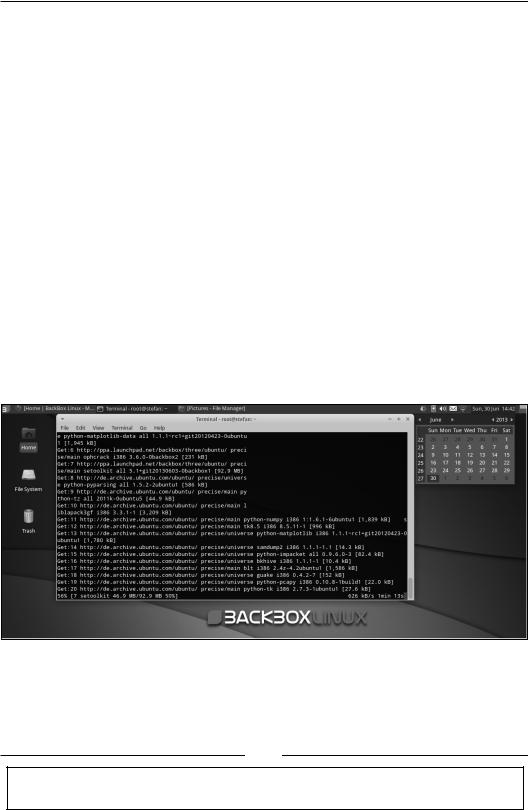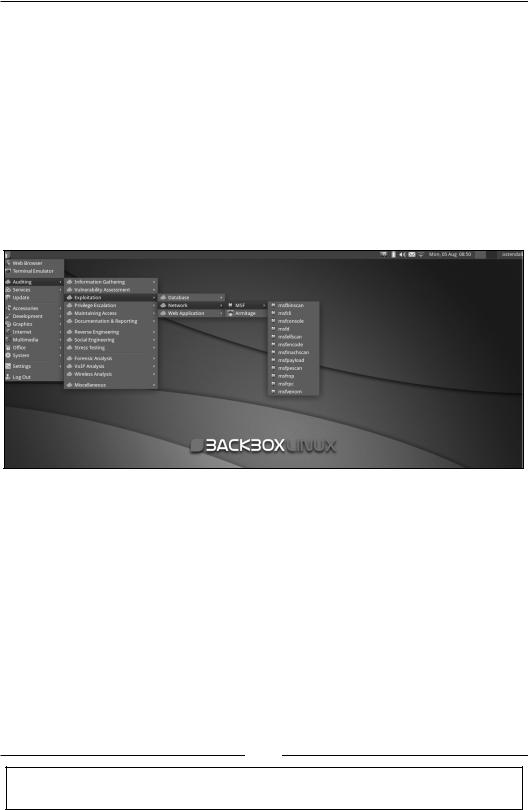
Penetration Testing with BackBox
.pdf
Penetration Testing with BackBox
Stefan Umit Uygur
Chapter No. 1
"Starting Out with BackBox Linux"

In this package, you will find:
A Biography of the author of the book
A preview chapter from the book, Chapter NO.1 "Starting Out with BackBox Linux"
A synopsis of the book’s content Information on where to buy this book
About the Author
Stefan Umit Uygur has been an IT System and Security engineer for 14 years. He is an extremely motivated open source software evangelist with a passion for sharing knowledge and working in a community environment. He is highly experienced in Penetration Testing and Vulnerability Analysis, Management, and Assessment. He has
been involved in many open source software projects, for example BackBox, where he is part of the core team. He has helped to promote the free software culture around the world by participating and organizing international conferences. He significantly contributes to shedding the false and negative perceptions around hacking and hackers by promoting the hacker world in a positive light. He explains in detail the real world of hacking, hackers' motivations, and their philosophy, ethics, and freedom. These activities are promoted mainly through national and international magazines, and in particular, during the conferences that he participates. Along with his professional activities, he has contributed to the Linux magazine, the PenTest magazine, and a few other small, periodic, technical publications.
For More Information:
www.packtpub.com/penetration-testing-with-backbox/book

However, his main passion is continuous collaboration with the community as he believes in the community more than anything else. He strongly feels that knowledge shouldn't be owned by a few people, but should be the heritage of the entire collective. He is always grateful to the community for the skills and the knowledge he possesses. One of the definitions he gives to the community is that it is the real school and university where one truly learns.
I would like to thank my ladybird who helped me out to proofread this entire book. Without her help, I wouldn't have been able to complete this publication in a reasonable timeframe.
For More Information:
www.packtpub.com/penetration-testing-with-backbox/book

Penetration Testing with BackBox
Penetration testing is a crucial method of proactively securing your ICT infrastructure. BackBox is an Ubuntu-derived Linux distribution designed for penetration testing that provides the user with a powerful set of the best known ethical hacking tools and easy updating procedures.
This book is designed with two prime learning objectives: a complete introduction to the penetration testing methodology and how to begin using BackBox to execute those methodologies. It starts with an overview of BackBox and its toolset, before outlining the major stages of penetration testing. Towards the end of the book, you'll go through a full penetration test case and learn how to use BackBox to provide full documentation and reporting.
What This Book Covers
Chapter 1, Starting Out with BackBox Linux, introduces BackBox Linux and the organization of the tools and services with a brief description of the tools included.
Chapter 2, Information Gathering, introduces us to a few ways of collecting useful information about the target system.
Chapter 3, Vulnerability Assessment and Management, explains how to perform vulnerability scans.
Chapter 4, Exploitations, uses the information we have collected in the previous chapters.
Chapter 5, Eavesdropping and Privilege Escalation, helps us in performing eavesdropping and privilege escalation on the target system where we already gained access by having obtained the access credentials in the previous chapter.
Chapter 6, Maintaining Access, helps us to set up backdoors in order to maintain access without repeating the steps covered in the previous chapters.
Chapter 7, Penetration Testing Methodologies with BackBox, helps us to perform a complete penetration test step-by-step, starting from information gathering to gaining access.
Chapter 8, Documentation and Reporting, explains how to create human-readable reports of our auditing tasks.
For More Information:
www.packtpub.com/penetration-testing-with-backbox/book

Starting Out with
BackBox Linux
Welcome to the first chapter of this book, which will be based on full penetration testing methodologies using BackBox. We will acquire in-depth knowledge of BackBox by familiarizing ourselves with its various tools and functions.
It is highly recommended that readers have a prior general understanding of Linux systems and an average level of knowledge concerning shell environments.
In this first chapter, we will introduce BackBox Linux, the organization of the tools and services with a brief description of the tools included.
A flexible penetration testing distribution
BackBox Linux is a very young project designed for penetration testing, vulnerability assessment and management. The key focus in using BackBox is to provide an independent security testing platform that can be easily customized with increased performance and stability. BackBox uses a very light desktop manager called XFCE. It includes the most popular security auditing tools that are essential for penetration testers and security advisers. The suite of tools includes web application analysis, network analysis, stress tests, computer sniffing forensic analysis, exploitation, documentation, and reporting.
For More Information:
www.packtpub.com/penetration-testing-with-backbox/book

Starting Out with BackBox Linux
The BackBox repository is hosted on Launchpad and is constantly updated to the latest stable version of its tools. Adding and developing new tools inside the distribution requires it to be compliant with the open source community and particularly the Debian Free Software Guidelines criteria. IT security and penetration testing are dedicated sectors and quite new in the global market. There are a lot of Linux distributions dedicated to security; but if we do some research, we can see that only a couple of distributions are constantly updated. Many newly born projects stop at the first release without continuity and very few of them are updated.
BackBox is one of the new players in this field and even though it is only a few years old, it has acquired an enormous user base and now holds the second place in worldwide rankings. It is a lightweight, community-built penetration testing distribution capable of running live in USB mode or as a permanent installation. BackBox now operates on release 3.09 as of September 2013, with a significant increase in users, thus becoming a stable community. BackBox is also significantly used in the professional world.
BackBox is built on top of Ubuntu LTS and the 3.09 release uses 12.04 as its core. The desktop manager environment with XFCE and the ISO images are provided for 32-bit and 64-bit platforms (with the availability on Torrents and HTTP downloads from the project's website). The following screenshot shows the main view of the desktop manager, XFCE:
[ 6 ]
For More Information: www.packtpub.com/penetration-testing-with-backbox/book

Chapter 1
The choice of desktop manager, XFCE, plays a very important role in BackBox. It is not only designed to serve the slender environment with medium and low level of resources, but also designed for very low memory. In case of very low memory and other resources (such as CPU, HD, and video), BackBox has an alternative way of booting the system without graphical user interface (GUI) and using commandline only, which requires really minimal amount of resources. With this aim in mind, BackBox is designed to function with pretty old and obsolete hardware to be used as a normal auditing platform. However, BackBox can be used on more powerful systems to perform actions that require the modern multicore processors to reduce ETA of the task such as brute-force attacks, data/password decryption,
and password-cracking. Of course, the BackBox team aims to minimize overhead for the aforementioned cases through continuous research and development. Luckily, the majority of the tools included in BackBox can be performed in a shell/console environment and for the ones which require less resource. However, we always have our XFCE interface where we can access user-friendly GUI tools (in particular network analysis tools), which do not require many resources.
Relatively, a newcomer into the IT security and penetration testing environment, the first release of BackBox was back in September 09, 2010, as a project of the Italian web community. Now on its third major release and close to the next minor release (BackBox Linux 3.13 is planned for the end of January 2014), BackBox has grown rapidly and offers a wide scope for both amateur and professional use.
The minimum requirements for BackBox are as follows:
•A 32-bit or 64-bit processor
•512 MB of system memory RAM (256 MB in case there will be no desktop manager usage and only the console)
•4.4 GB of disk space for installation
•Graphics card capable of 800 × 600 resolution (less resolution in case there will be no desktop manager usage)
•DVD-ROM drive or USB port
[ 7 ]
For More Information: www.packtpub.com/penetration-testing-with-backbox/book

Starting Out with BackBox Linux
The following screenshot shows the main view of BackBox with a toolbar at the bottom:
The suite of auditing tools in BackBox makes the system complete and ready to use for security professionals of penetration testing.
The organization of tools in BackBox
The entire set of BackBox security tools are populated into a single menu called Audit and structured into different subtasks as follows:
•Information Gathering
•Vulnerability Assessment
•Exploitation
•Privilege Escalation
•Maintaining Access
•Documentation & Reporting
[ 8 ]
For More Information: www.packtpub.com/penetration-testing-with-backbox/book

Chapter 1
•Social Engineering
•Stress Testing
•Forensic Analysis
•VoIP Analysis
•Wireless Analysis
•Miscellaneous
In this book, we will be performing our practical actions by using nearly half of the tools included in BackBox Linux.
We have to run through all the tools in BackBox by giving a short description of each single tool in the Auditing menu. The following screenshot shows the Auditing menu of BackBox:
Information Gathering
Information Gathering is the first absolute step of any security engineer and/or penetration tester. It is about collecting information on target systems, which can be very useful to start the assessment. Without this step, it will be quite difficult and hard to assess any system. We will be quickly running through this menu and giving a short definition of the tools in it:
•Arping: This is a utility that sends ARP requests to the hosts on a specific subnet.
•Arp-scan: This is a command-line tool designed for system discovery and fingerprinting. It assembles and sends ARP requests to specified IP addresses, displaying any responses that are received.
[ 9 ]
For More Information: www.packtpub.com/penetration-testing-with-backbox/book

Starting Out with BackBox Linux
•Automater: This is an automated tool for intrusion analysis based on URL, IP address, or hash.
•Knock: This is a Python script designed to enumerate subdomains on a target domain through a wordlist.
•Nbtscan: This is an application to scan and get information about IP networks for NetBIOS name information.
•Sslyze: This is designed to be fast and comprehensive and help organizations and testers to identify misconfigurations that are affecting their SSL Servers.
•theHarvester: This is an information collector used to harvest e-mails, subdomains, hosts, and personal information about individuals.
•Zenmap: This is the official Nmap Security Scanner GUI frontend.
•Recon-ng: This is a full-featured Web Reconnaissance framework.
•WhatWeb: This is an application that recognizes web technologies including content management systems (CMS), blogging platforms, statistic/analytics packages, JavaScript libraries, web servers, and embedded devices.
•Creepy: This is a web application security assessment report generator.
Vulnerability Assessment
After you've gathered information by performing the first step, the next step will be to analyze that information and its evaluation. Vulnerability Assessment is the
process of identifying the vulnerabilities present in the system and prioritizing them. The tools are briefly described as follows:
•Cvechecker: This is a tool that generates a report about possible vulnerabilities in your system by comparing the result with the information in its common vulnerability environment (CVE) database.
•RIPS: This is a static source code analyzer for vulnerabilities in PHP web applications.
•OpenVAS: This is a framework composed of several services and tools to deliver a comprehensive, powerful vulnerability scanning management solution.
•Nikto: This is a web server scanner that tests web servers for dangerous files/CGIs, outdated server software, and other problems.
[ 10 ]
For More Information: www.packtpub.com/penetration-testing-with-backbox/book
